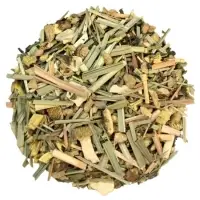

PRODUCT INFO Yellow chinese chive Leaves grow in clumps of slender, elongated leaves averaging 15 to 20 centimeters in length and have a cylindrical appearance ending in a curved tip. The leaves are thin, delicate, and flat, notably solid and not hollow. Yellow chinese chive Leaves are wider than common garden chives and showcase pale shades of yellow and white, the coloring dependent on the growing conditions. Each leaf has a crisp, succulent, and tender consistency and is easily damaged as they are fragile in nature. Yellow chinese chive Leaves are known for their robust, garlic-like aroma and have a clean, vegetal flavor mixed with mildly sweet nuances of garlic and onions. USES Yellow chinese chive leaves and peppery, Chinese celery tastes similar to regular celery, only much stronger - it is rarely eaten raw. Toss in stir-fries, fried rice dishes or vegetable sautes. Pair with ham, lamb, chicken, turkey or game entrees. To store, place in a perforated plastic bag refrigerate. Do not wash until ready to use. To clean, rinse quickly under water. Gently shake off excess water pat dry. SEASONS Yellow chinese chive leaves are available year-round, with peak seasons in the spring and summer.

PRODUCT INFO Kitchen Mint (Bai Saranae) it is a ground cover plant. Leaves are fortified, green, leaf margins wrinkled, prefer loamy soil, easy to grow, grow quickly. if well cared for The leaves will be beautiful and the leaves will be collected faster. It is used to cook spicy salads, larb, and tom yam dishes. And help flavor to make it more appetizing. In addition, it is also used to make medicine and extract essential oils that are used in many industries. USES Mint (English: Kitchen Mint) can be used both in sweet and savory dishes. Add mint to new potatoes or to a garlic and cream cheese dip. Mix mint with chocolate cakes or bake with raisins and currants in pastry. Mints are an excellent addition to sauces, syrups, vinegars, and teas. SEASONS Kitchen Mint is available between July - Oct each year.
Rosemary is from the mint family. Native to the Mediterranean region. Rosemary is popular for its medicinal uses but is now more commonly known as a seasoning used in cooking. It has a tea-like aroma and bittersweet clean fresh flavour. Our process involves the cleaning and sizing of this product to our customer specifications. Scientific Name: Rosemarinus Officinalis Qualities: Whole, Cut, Chopped & Ground Bulk: Cartoon boxes, polypropylene bags, etc., 10 kg, 20 kg, 25 kg, 50 kg, etc
Price : INR 550.00 / Kilogram Business Type : Manufacturer, Exporter, Supplier Product Details Certification : FSSAI Application : Cooking Feature : Easy To Digest, No Preservatives Form : Husk Packaging Type : Plastic Packet Packaging Size : 500 gm-1 kg Preferred Buyer From Location : All Countries Except India
Citronella grass (Cymbopogon nardus and Cymbopogon winterianus) grow to about 2 m (6.6 ft) and have magenta-colored base stems. These species are used for the production of citronella oil, which is used in soaps, as an insect repellent (especially mosquitoes) in insect sprays and candles, and in aromatherapy. The principal chemical constituents of citronella, geraniol and citronellol, are antiseptics, hence their use in household disinfectants and soaps. Besides oil production, citronella grass is also used for culinary purposes, as a flavoring. East Indian lemongrass (Cymbopogon flexuosus), also called Cochin grass or Malabar grass, is native to Cambodia, Vietnam, Laos, India, Sri Lanka, Burma, and Thailand, while West Indian lemongrass (Cymbopogon citratus) is native to maritime Southeast Asia. While both can be used interchangeably, C. citratus is more suitable for cooking. In India, C. citratus is used both as a medical herb and in perfumes. C. citratus is consumed as a tea for anxiety in Brazilian folk medicine, but a study in humans found no effect. The tea caused a recurrence of contact dermatitis in one case.
Citronella grass (Cymbopogon nardus and Cymbopogon winterianus) grow to about 2 m (6.6 ft) and have magenta-colored base stems. These species are used for the production of citronella oil, which is used in soaps, as an insect repellent (especially mosquitoes) in insect sprays and candles, and in aromatherapy. The principal chemical constituents of citronella, geraniol and citronellol, are antiseptics, hence their use in household disinfectants and soaps. Besides oil production, citronella grass is also used for culinary purposes, as a flavoring. East Indian lemongrass (Cymbopogon flexuosus), also called Cochin grass or Malabar grass, is native to Cambodia, Vietnam, Laos, India, Sri Lanka, Burma, and Thailand, while West Indian lemongrass (Cymbopogon citratus) is native to maritime Southeast Asia. While both can be used interchangeably, C. citratus is more suitable for cooking. In India, C. citratus is used both as a medical herb and in perfumes. C. citratus is consumed as a tea for anxiety in Brazilian folk medicine, but a study in humans found no effect. The tea caused a recurrence of contact dermatitis in one case.
Peppermint (Mentha piperita, also known as Mentha balsamea Wild) is a hybrid mint, a cross between water mint and spearmint. Indigenous to Europe and the Middle East, the plant is now widely spread and cultivated in many regions of the world. It is occasionally found in the wild with its parent species.
Peppermint (Mentha piperita, also known as Mentha balsamea Wild) is a hybrid mint, a cross between water mint and spearmint. Indigenous to Europe and the Middle East, the plant is now widely spread and cultivated in many regions of the world. It is occasionally found in the wild with its parent species.
Peppermint (Mentha piperita, also known as Mentha balsamea Wild) is a hybrid mint, a cross between water mint and spearmint. Indigenous to Europe and the Middle East, the plant is now widely spread and cultivated in many regions of the world. It is occasionally found in the wild with its parent species.






